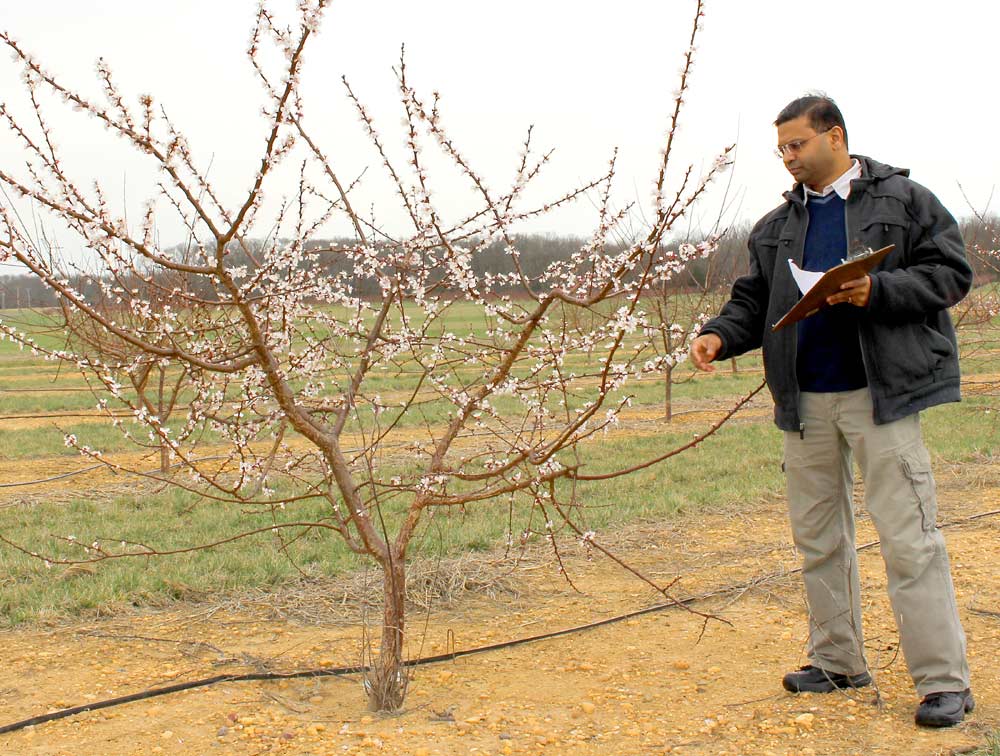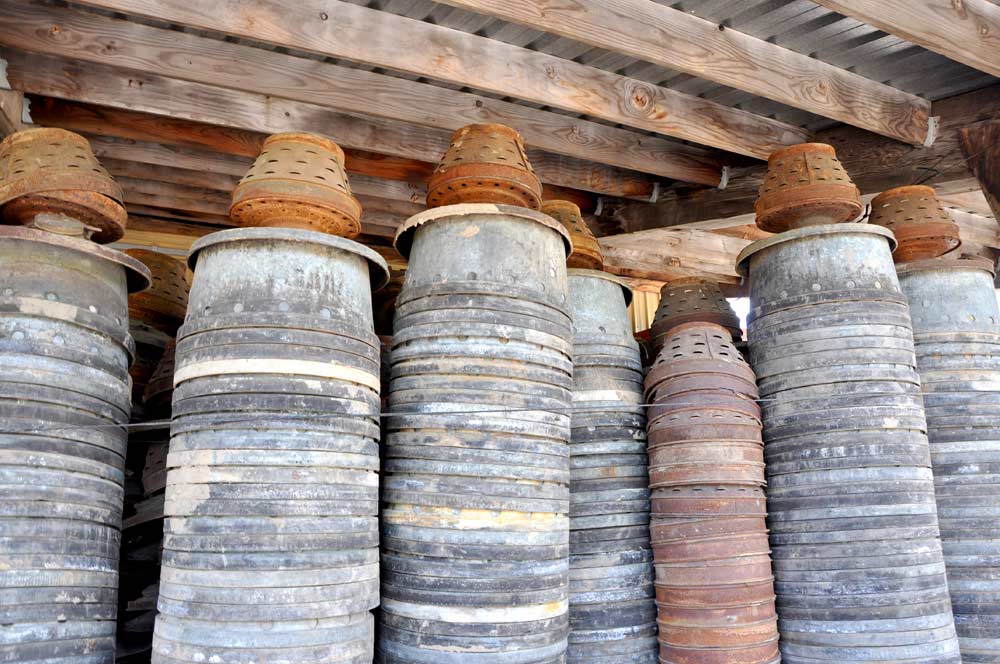
Hemant Gohil, wine grape and fruit extension agent at the New Jersey Agricultural Experiment Station, examines flower damage in an apricot orchard after a major frost event in Bridgeton, New Jersey, in April 2016. To help growers respond as effectively as possible to events like this one, he has compiled information about different frost-protection methods. (Courtesy New Jersey Agriculture Experiment Station)
When most people are reveling in the warmth of a sunny spring afternoon, stone fruit growers can’t help but think about whether that clear sky might herald a killing nighttime frost. As temperatures edge downward, that anxiety turns into action as they work to fend off the layer of icy crystals.
But what actually works best to keep crops safe? With frost events seemingly becoming more frequent and causing more damage, that is a question worthy of exploration, according to Hemant Gohil, wine grape and fruit extension agent at Rutgers University’s New Jersey Agricultural Experiment Station.
As an example, he pointed to the swing in temperatures in parts of New Jersey in 2016: unseasonably warm temperatures in late March that pushed up the peach bloom, followed by a cold snap and frost in early April that damaged half or more of those flowers.
To help growers make better decisions about frost protection, Gohil has not only scoured the trade literature, but also conducted a panel discussion at the 2018 Mid-Atlantic Fruit and Vegetable Convention with growers and others who have expertise with different frost-protection techniques. They included Delaware orchardist Bobby Fifer, Pennsylvania orchardist Mark Boyer, Donald Smith of the Penn State Fruit Experiment Station, William Mackintosh of Crop Production Services, and private researcher Donald Ganske.
Through it all, Gohil has learned the costs and requirements associated with different strategies and which are effective at the lowest temperatures.
Stationary heaters
Stationary heaters, or smudge pots, are the least effective of the methods Gohil reviewed.
A typical stone-fruit orchard requires 36 well-placed smudge pots per acre to provide good coverage of the trees, and they only work when a strong inversion layer, or blanket of warm air, is present at no more than 40 to 50 feet above the orchard (to keep heat in the orchard), and when slow winds are present to move the heat through the trees. Once winds reach 10 mph, however, heat blows right out of the orchard.
Even under optimal conditions, he said, experienced growers report that smudge pots are able to increase the temperature no more than 3 degrees Fahrenheit.
Cost is another issue.
“The use of heaters is one of the most expensive frost-protection methods, with the smudge pots themselves running about $75 each ($2,700 per acre), and in-ground fuel lines about $4,500 per acre,” he said. Fuel prices and the number of heating hours can vary from use to use, but he put the average combined cost at about $82 per acre per night.
On the up side, thermostat-controlled heaters incur almost no labor costs.

Among the methods reviewed, Gohil said smudge pots are least effective. Costs are high at about $7,200 per acre for the pots and in-ground fuel lines, plus another $82 in fuel costs per acre per night. (Courtesy Tracy Robillard/Natural Resources Conservation Service Oregon)
Wind machines
Wind machines carry high initial price tags of $25,000 to $40,000 per machine, but each machine covers up to 10 acres and has operating expenses (including fuel costs) of only about $10 per acre, Gohil said.
The machines draw warm air from the inversion layer and mix it with cold surface air, and this alone can generally raise the orchard temperature by 2 to 3 degrees F, and sometimes 1 to 2 degrees more if the inversion layer is low.
On colder nights, he said, many wind machines are equipped with thermostats to automatically control attached heaters. Such machines can bump up the temperature by another couple of degrees, but this adds to the fuel costs.
Growers reported that placement of a wind machine is critical.
“For a machine that covers 900 feet, it should be placed 300 feet down from the edge of the upwind side and 600 feet up from the edge of the downwind side, and you can use small helium balloons or smoke to find the usual seasonal airflow direction,” he said.
Thermablasters/Frost Dragons
Portable heating machines, such as Thermablasters or Frost Dragons, are powered by tractor-mounted propane tanks. The machines, which have been used in South America for several years, blow flame-heated air toward crops.
“For these, you use at least a 65-horsepower tractor with front-end weights to pull the heavy tanks and the heater, which has vents on the sides to apply the heat,” Gohil said.
According to one of the growers who has mastered this technique, the maximum speed should be around 4 to 4.5 mph, and you have to return to the same spot before the heat dissipates, usually in less than 10 minutes, he said, noting that on a low-wind night, one Frost Dragon is able to heat about 5 acres of flat terrain.
Given that these machines cost about $25,000, the most economical way to use them is to monitor bloom development and target only those plots that need the most protection.
“The good thing about Frost Dragons is that they could save blooms at an ambient temperature down to 18.6 degrees F, and that’s very low,” he said.
Fuel and labor costs together average $54 per night per acre, and high fuel use requires one or more quick tank refills during the night to maintain the tight 10-minute schedule.
Overhead irrigation
Many growers already use overhead irrigation, so sprinkling for frost is not only a cost-effective option, but one that is “very effective because you are directly targeting the tissues,” Gohil said.
To do it correctly, growers must begin sprinkling when the wet bulb temperature (or “feels-like” temperature) is between 32 and 34 degrees F, and depending on relative humidity, this may be 5 to 7 degrees F below the air-temperature reading.
Growers reported that overhead sprinkling could protect against frost down to air temperatures of 23 degrees F, but did not work on nights when the wind topped 10 mph, he noted.
The major cost associated with overhead sprinkling was water usage, which varies depending on the grower’s water source.
In selecting what works best for their orchards, Gohil offered this general advice: Estimate possible damage costs and compare them to the outlays associated with the various frost methods, and pick one or possibly a combination of them to protect the crop from frost.
And, of course, continue to watch the weather. •
Session details:
Gohil will present “Frost Protection Options in Tree Fruit Crops” at the Great Lakes Fruit, Vegetable and Farm Market EXPO Dec. 5 in Grand Rapids, Michigan. Details about the EXPO are available here: www.glexpo.com/2018-gl-expo-education-program
-by Leslie Mertz






Leave A Comment